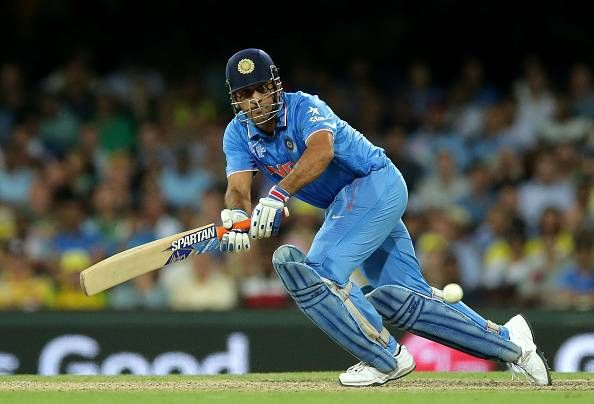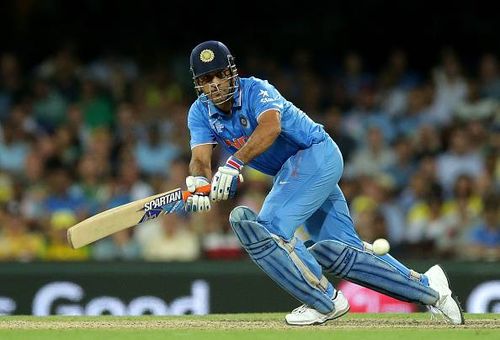
MS Dhoni - A tribute to the man who transformed limited-overs cricket

On 23rd December 2004, MS Dhoni, a long-haired Ranchi boy, won his first ODI cap for India. In a matter of 10-11 years, not only has he become India’s most successful captain, but he’s also changed the limited-overs game in ways that one could only dream of.
The only Indian to have won a hundred ODIs as captain and only the third person ever to do so, Dhoni, was given his first shot as captain of India during the inaugural ICC World Twenty20 (T20) held in South Africa in September 2007. He led India to a historic victory, beating Pakistan in the final and was later handed the ODI captaincy for the 7-match series against Australia, the same year. He has since won the ICC Cricket World Cup in 2011, the ICC Champions Trophy in 2013, 2 Indian Premier League (IPL) titles and two Champions League T20 (CL T20) titles for the Chennai Super Kings. He was named the ICC ODI Player of the Year in 2008 and 2009 and has been part of the ICC ODI World XI every year from 2008 to 2014.
India had realized the importance of having a good wicket-keeper batsman in the early 2000s when Sourav Ganguly had famously handed Rahul Dravid the wicket-keeping gloves. Dhoni had made a mark playing for India A and was a natural replacement in the national side for the non-performing duo of Parthiv Patel and Dinesh Karthik. Dhoni did not have the best of starts to his career, getting run out for a duck against Bangladesh. He was, however, persisted with for the series against Pakistan and made his mark scoring a 123-ball 148 not out in the second match of the series.
In the following series against Sri Lanka, Dhoni amassed a record-breaking 183 not out at the Sawai Mansingh Stadium in Jaipur to help India chase Sri Lanka’s 298. He was awarded the Man of The Series award and ended the series as the highest run-getter. He was handed a B- Grade contract by the BCCI in the aftermath of that series, a feat which spelt the start of his illustrious association with the BCCI.
Dhoni went on to lead the ranking charts for ODI batsmen for several months in 2009 when he scored 1194 runs in 24 innings at an astonishing average of 70.43. He had brought his symbolic unorthodox mannerisms to the forefront of international cricket. The composure in his batting reflected in his captaincy and he was soon handed the title of ‘Captain Cool’.
A pioneer of chasing totals
The ease with which he would break down daunting run chases into small segments started to become the norm for cricketers chasing big totals. Dhoni had become known to stifle the opposition from scoring runs in the middle overs with the clever usage of spin bowling. However precarious the situation be, it always seemed like he was in control, slipping in a couple of tight overs of spin bowling.
There is perhaps no captain in the world who uses part-time bowlers better than Dhoni. Whenever his team is a bowler short or starts to have a bad day, Dhoni would wait for a wicket to fall and then slip in some overs from part-time bowlers to make up as the extra bowler. Most players who have played under him credit him for the immense trust that he would show in them.
Allowing the lesser known Joginder Sharma to bowl the final over of the World Twenty20 final in 2007 is a great example of this facet. He also showed immense backing in his instincts when he famously promoted himself up the batting order ahead of the in-form Yuvraj Singh for the final of the 2011 Cricket World Cup. He also displayed these instincts when he allowed Ishant Sharma, who had gone for plenty of runs previously, to bowl the penultimate over of the ICC Champions Trophy final in 2013. Ishant managed to take two important scalps in that over as India edged past England to be champions.
These subtleties have come to be synonymous with Dhoni’s captaincy over the years, but there was nothing quite as synonymous as was Dhoni finishing off matches by hitting the ball out of the park. Engraved into memory forever will be the six that he hit over long-on to finish off the 2011 Cricket World Cup at the Wankhede Stadium in Mumbai. Dhoni will always be remembered as the inventor of the helicopter shot, arguably, the first ever attempt to score a boundary off a yorker in an unorthodox manner.
He is famous for taking a run-chase well into the last overs before attempting a risky shot and he always believed that by doing this, he gave his team the maximum chance of winning the match. This art of taking matches right down to the wire may have had its critics but is proven to have been successful in the numerous victories that it brought. It is, therefore, not surprising today that Dhoni is regarded as the best finisher in world cricket.
Dhoni’s professionalism must be lauded
Staying away from the limelight and focusing on the job in hand are only small indications that show the brilliant human being that Dhoni is. He has had his own share of controversies, but there is no doubt as to the true professional that he is. He depicted his dedication to the sport when he refused to return home from Australia for the birth of his daughter a few months ago.
He had also, previously, opted to retire from Test cricket very silently by announcing his decision through the BCCI, thereby showing his willingness to stay away from hogging the limelight.
With Virat Kohli taking over as Test captain and the emergence of a solid batting order, Dhoni has left the Indian Test Side in safe hands. Indian cricket will always be indebted to its greatest ever captain for taking it to monumental heights. With a younger force taking on the mantle, the man with the Midas touch may not carry on playing for India for long, but his philosophies will remain with the Indian team for years to come.